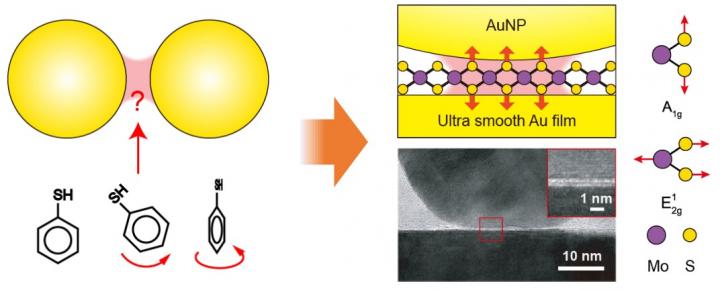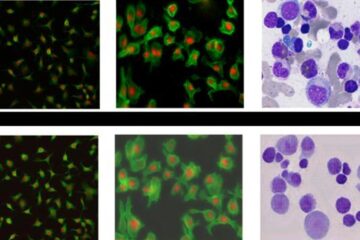2D atomic crystals probe: how hot it is in a plasmonic 'hotspot'

Conventional SERS probes using molecule are hard to control while a 2D material is perfect probe to the plasmonic fields in a nanogap. Credit: Wen Chen, Shunping Zhang, Meng Kang, Weikang Liu, Zhenwei Ou, Yang Li, Yexin Zhang, Zhiqiang Guan, Hongxing Xu, Probing the limits of plasmonic enhancement using a two-dimensional atomic crystal probe, Light: Science and Applications, doi: 10.1038/s41377-018-0056-3.
Measuring surface-enhanced Raman scattering (SERS) signal from a probe inside the nanogap region is a promising avenue to do that, but it still faces several intractable issues: (i) how to create a width-controllable subnanometer gap with well-defined geometry, (ii) how to insert the nanoprobe into such narrow gap, and more importantly, (iii) how to control the alignment of the probe with respect to the strongest plasmonic field component.
What's more, the excitation laser should match with the plasmonic resonances in both wavelength and polarization, to get the maximum plasmonic enhancement. These requirements are difficult to satisfy simultaneously in traditional SERS using molecules as probe.
To overcome all these limitations, a research group led by Shunping Zhang and Hongxing Xu at Wuhan University, China, has developed a quantitative SERS technique to probe the maximum plasmonic fields before effects such as electron tunneling become dominant.
The researchers turned to molybdenum disulfide (MoS2)- a graphene-like, two-dimensional atomic layer to tune the distance between a gold nanoparticle and a smooth gold film. For the first time, the plasmonic near-field components in vertical and horizontal directions within atom-thick plasmonic nanocavities were quantitatively measured by using tiny flakes of two-dimensional atomic crystals as probes.
In their configuration, the researchers can ensure that the probe filled in the gap has a well-defined lattice orientation such that the lattice vibrations are precisely aligned with the plasmonic field components.
These lattice probes are free of optical bleaching or molecule hopping (in/out of the hotspot) as in traditional SERS experiments. They achieved the quantitative extraction of plasmonic fields in the nanogap by measuring the SERS intensity from the out-of-plane and in-plane phonon modes of the MoS2.
The robustness of the 2D atomic crystal as SERS probes promote SERS to be a quantitative analytic tool instead of a qualitative one in most previous applications.
Also, these unique designs could provide an important guide for further understanding quantum mechanical effects as well as plasmon-enhanced photon-phonon interactions and promoting relevant new applications, such as quantum plasmonics and nanogap optomechanics.
Media Contact
More Information:
http://dx.doi.org/10.1038/s41377-018-0056-3All latest news from the category: Physics and Astronomy
This area deals with the fundamental laws and building blocks of nature and how they interact, the properties and the behavior of matter, and research into space and time and their structures.
innovations-report provides in-depth reports and articles on subjects such as astrophysics, laser technologies, nuclear, quantum, particle and solid-state physics, nanotechnologies, planetary research and findings (Mars, Venus) and developments related to the Hubble Telescope.
Newest articles

Bringing bio-inspired robots to life
Nebraska researcher Eric Markvicka gets NSF CAREER Award to pursue manufacture of novel materials for soft robotics and stretchable electronics. Engineers are increasingly eager to develop robots that mimic the…

Bella moths use poison to attract mates
Scientists are closer to finding out how. Pyrrolizidine alkaloids are as bitter and toxic as they are hard to pronounce. They’re produced by several different types of plants and are…

AI tool creates ‘synthetic’ images of cells
…for enhanced microscopy analysis. Observing individual cells through microscopes can reveal a range of important cell biological phenomena that frequently play a role in human diseases, but the process of…





















